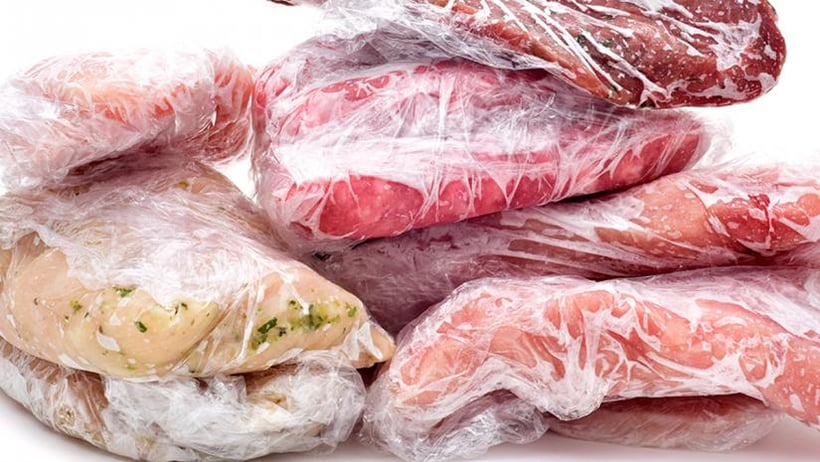
Controlling the temperature of food is an integral part of food safety. Harmful bacteria known as pathogens can breed on food, especially when food is kept at the “Temperature Danger Zone”. The Temperature Danger Zone is the temperature range (between 4°C and 60°C, 5°C and 60°C in Manitoba) at which pathogens can grow rapidly to unsafe levels on food and cause food poisoning. Food businesses must minimize the amount of time food is in the Temperature Danger Zone to lower the risk of food-borne illness.
One way to minimize this risk is to freeze food that is not being cooked or eaten immediately. Freezing food stops bacteria from reproducing, reducing the growth of harmful pathogens. However, freezing food does not kill the bacteria already on the food, which is why people should still follow food safety practices when freezing food. Ensure your food business is handling frozen food properly by implementing these best practices.
Receiving frozen food deliveries
Food businesses must always check food deliveries to ensure food safety. Frozen goods should always be delivered at -18°C / 0°F or below. Always use a calibrated thermometer to ensure food is being delivered at the right temperature.
Ensure that frozen meat and poultry products are tightly wrapped, frozen solid and do not show any signs of thawing. If there are signs of thawing, or if the packaging is damaged with tears or punctures, reject the delivery.
Fresh fish and fish fillets sold as “previously frozen” should still smell fresh and mild, so reject any previously frozen fish that smells too fishy, sour or rancid. Fish being used for sushi or sashimi should always be bought frozen from a trusted supplier.
How to properly freeze food
Freezers should be kept at a temperature of -18°C / 0°F or below in order to ensure the proper storage of frozen food. Additional best practices include:
- Prioritize storing high-risk foods such as poultry, meat, seafood, eggs and dairy products before less hazardous foods.
- If fresh meat or poultry will not be cooked within two days of receiving the food, it should be frozen instead of refrigerated.
- Meat and poultry should be wrapped in airtight packaging that are labelled and dated. It is best practice to label and date all items.
- Eggs can only be frozen if they’re not in their shells, as the shells will break.
- Dairy products can be frozen, but the quality of the food can be affected. For example, freezing cheese will affect its taste and texture.
- Produce typically freezes well and still retains its nutritional value when thawed. However, its texture and flavour can change if refrozen.
- Never refreeze poultry, meat, eggs or dairy products once thawed.
Food businesses that have walk-in coolers, fridges and freezers should be equipped with thermometers to ensure that employees can regularly check that the storage area is at the proper temperature. Make sure that the storage area isn’t overcrowded and that boxes aren’t blocking air vents as this could affect the air circulation and temperature.
Thawing frozen foods
It’s important to remember that freezing food does not kill bacteria, it just stops bacteria from reproducing. As food thaws, bacteria can reawaken and start to reproduce. This is especially dangerous for high-risk foods, which should be kept out of the Temperature Danger Zone.
To minimize the risk of bacteria multiplying while thawing, frozen foods should always be thawed in the refrigerator, where the temperature is kept at 4°C / 40°F or below. For frozen meat and poultry, this can take some time so be sure to plan ahead.
It is never okay to thaw frozen food at room temperature because there is a very high chance that the food will be left in the Temperature Danger Zone where pathogens can multiply easily.
Is it safe to serve freezer-burned food?
Freezer burn can occur when food is not properly wrapped or is stored for too long in the freezer. It can also occur when a freezer is fluctuating in temperature, so food businesses should check if their freezer is maintaining a temperature of -18°C / 0°F or below if they find food with freezer burn.
Freezer-burned food is generally still safe to serve and eat. However, the quality of the food can be affected by the loss of texture and taste. Even though it’s safe to eat, food businesses should avoid serving freezer-burned food as customers might notice that the dish tastes different and could even question the safety of the food being served.
Learn what causes freezer burn and the signs of freezer-burned food to determine which foods should be thrown away for quality issues. To prevent storing food in the freezer for too long, download the Canadian Institute of Food Safety’s (CIFS) Fact Sheet for Recommended Food Storage Times.




